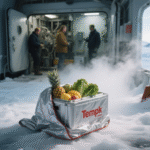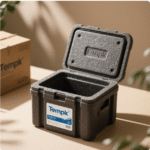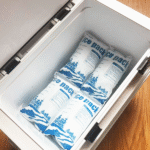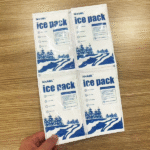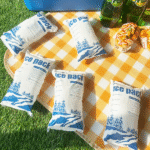Price Dry Ice Ice Pack: What’s the Real Cost in 2025?
If you’re comparing cooling options, the price dry ice pack you choose should reflect total landed cost, not sticker price. Within the first week of planning, you can benchmark $1–3 per lb retail, secure pallet tiers near $1.20–$1.60 per lb, and size mass with a simple formula to avoid over‑loading. You’ll cut claims, reduce waste, and keep your cargo safe end‑to‑end.
-
Understand what drives the price dry ice ice pack in real operations, from film to freight.
-
Convert unit price into door‑to‑door cost with surcharges and labor—so your price dry ice ice pack budget is accurate.
-
Size packs for 24–120 hours using practical rules and a quick calculator that keeps your price dry ice ice pack stable year‑round.
-
Decide when to mix gel packs with dry ice to lower weight and risk, reducing your price dry ice ice pack on long lanes.
What drives the price dry ice ice pack in 2025?
Short answer: the unit price matters, but total cost hinges on form, film, insulation, and quantity tiers for your price dry ice ice pack. Retail dry ice often lands around $1–$3 per lb, while volume tiers can drop to ~$1.60 per lb; reusable gel packs commonly run about $1–$2 each. Use tiers, better insulation, and precise sizing to reduce the price dry ice ice pack at the shipment level.
article_price_dry_ice_ice_pack
Why it works: Unit price ranges are wide because CO₂ supply, energy, and order size shift daily. In 2025 examples, tiered quotes fall rapidly as orders cross 100–150 lb, with public posts like Ben’s Dry Ice listing $6 → $1.60/lb across small to 150+ lb tiers. Gel packs look pricier per unit, yet re‑use and fewer fees often produce a lower cost‑per‑safe‑delivery and a more predictable price dry ice ice pack. Upgrade film thickness to prevent cracks, then trim mass 10–20% without risking temperature.
article_price_dry_ice_ice_pack
price-dry-ice-ice-pack-2025
How does insulation change the price dry ice ice pack per box?
High‑R shippers leak less heat, so you buy fewer kilograms. In EPS you may need 2.0–2.5 kg per 20 L per 24 h. PUR can cut that to ~1.6–2.0 kg; VIP can reach ~1.2–1.6 kg. When you multiply by days, the price dry ice ice pack falls because you load fewer packs and pay less freight. Pilot with data loggers before locking the spec.
price-dry-ice-ice-pack
| Insulation | Typical wall | kg/24 h @ 20 L | What this means for you |
|---|---|---|---|
| Corrugated | 5–7 mm | 4.0–5.0 | Only for cool weather or short holds |
| EPS | 25–30 mm | 2.0–2.5 | E‑commerce standard; solid balance |
| PUR | 25–40 mm | 1.6–2.0 | Fewer packs; lower freight weight |
| VIP | 10–20 mm | 1.2–1.6 | Best for 72–120 h; smallest cube |
Practical tips that immediately lower your price dry ice ice pack
-
Pre‑condition everything: Chill product and shipper to target temperature first.
article_price_dry_ice_ice_pack
-
Mix formats: Base with bricks, wrap sides with sheets, top off lightly.
article_price_dry_ice_ice_pack
-
Vent correctly: Small vents stop bursts without hurting hold time.
price-dry-ice-ice-pack
-
Right‑size the box: Tight cubes cut convective losses and pack count.
article_price_dry_ice_ice_pack
Case study: A meal‑kit lane cut film failures by upgrading to 130–150 μm laminate and adding vents. Dry ice mass dropped ~10%, failures fell 80%, and total landed cost per box decreased by ~$3 compared with the previous build.
price-dry-ice-ice-pack
How much should you load—and how does it affect the price dry ice ice pack?
Use a simple sizing method, then tune by season. Start with:Dry Ice (kg) ≈ 0.10 × Box Volume (L) × Days × IF where IF is 1.0 (EPS), 0.8 (PUR), 0.7 (VIP). Add 10% for warm routes and 20% for hot routes. Convert to 0.5 kg sheets and 1.0 kg bricks to balance surface contact and time. This keeps the price dry ice ice pack predictable across lanes.
price-dry-ice-ice-pack
Example: 48 h, 20 L EPS → 0.10 × 20 × 2 × 1.0 = 4.0 kg. Mix 2 × 1 kg bricks and 4 × 0.5 kg sheets. With bricks at $2.90 and sheets at $1.85, unit spend is $15.50 before freight and labor. Trim 10–15% in summer by moving to PUR liners or by improving load layout.
price-dry-ice-ice-pack
Format choice: which mix lowers your price dry ice ice pack?
| Format | Best use | Watch‑outs | Cost angle |
|---|---|---|---|
| Sheets (0.5 kg) | Side/top contact; fast pull‑down | Higher surface area → faster loss | Lowest $/kg; ideal for shaping |
| Bricks (1 kg) | Stable base; long hold | Less conformal | Slightly higher $/kg; “time insurance” |
| Pouches (0.5–1 kg) | Clean handling, low dust | Typically pricier | Saves labor in pharma/e‑com |
Tip: Treat sheets as “surface control” and bricks as “time insurance.” Size for days, then fill voids with pellets only when needed to optimize price dry ice ice pack.
price-dry-ice-ice-pack
Quick calculator (copy into your SOP)
price-dry-ice-ice-pack
From unit price to door‑to‑door price dry ice ice pack: what fees matter?
Door‑to‑door cost = unit price + surcharges + packaging + labor + failures—the real price dry ice ice pack that finance sees. Retail sits near $1–$3 per lb; pallet tiers can be ~$1.20–$1.60 per lb. Many carriers add a modest dry‑ice surcharge per package. Hazard labels and paperwork apply above certain thresholds; gel packs are non‑hazardous. Control each lever to reduce the price dry ice ice pack that finance actually sees.
price-dry-ice-ice-pack-2025
article_price_dry_ice_ice_pack
What changes the invoice most: Good insulation shrinks mass. Local suppliers reduce sublimation and inbound freight. Reusable gel packs spread cost across dozens of turns. Hybrid builds (gel + dry ice) often cut 20–30% of dry ice mass while holding temperature through delays.
article_price_dry_ice_ice_pack
Cost elements at a glance
| Element | What to watch | How to cut cost |
|---|---|---|
| Unit price | Volume tiers, seasonality | Lock annual tiers; dual‑source |
| Inbound freight | Distance, heat exposure | Regional suppliers; palletize |
| Packaging | R‑value, voids | Upgrade insulation; pack tight |
| Labor | Counting, dust | Pre‑counted cases; dispensers |
| Failures | Cracks, leaks, thaw | Thicker film; correct vents |
Dry ice vs gel packs: which lowers your price dry ice ice pack long‑term?
Both have a place; choose by temperature and time. Dry ice is cheaper per kg but you often need more mass for long holds; it’s single‑use and regulated above certain weights. Gel packs cost more per unit but are reusable and non‑hazardous, which simplifies shipping and reduces recurring spend. Many teams run hybrid builds to get the best of both.
article_price_dry_ice_ice_pack
Rules of thumb: For 48 h holds, plan ~1 kg dry ice per kg of payload in classic parcel shippers, versus ~0.35 kg of gel packs per kg for refrigerated ranges. Keep dry ice above the product and gel packs beside it to buffer extremes and slow sublimation.
article_price_dry_ice_ice_pack
Practical scenarios
-
Frozen desserts, 72 h summer lane: VIP shipper + bricks base + thin sheet top; trim mass 20%.
-
Meal kits, 48 h spring lane: EPS shipper + gel packs only; re‑use packs weekly.
-
Biologics, 96 h air lane: PUR or VIP + hybrid (gel next to vials, dry ice above) to protect labels and reduce CO₂ handling.
article_price_dry_ice_ice_pack
Field result: Switching to reusable gel for one‑day zones reduced weekly purchases by half, while maintaining product temperatures with fewer claims and lowering price dry ice ice pack exposure.
article_price_dry_ice_ice_pack
2025 trends shaping the price dry ice ice pack
What’s new in 2025: Suppliers are posting more transparent tiers, CO₂ capture is improving availability, and bio‑based gels extend 2–8 °C hold time. Smart sensors inside packs track temperature and sublimation, letting you right‑size loads seasonally. The net effect: you can hit targets with fewer kilograms and lower risk when you standardize builds and verify with data.
article_price_dry_ice_ice_pack
Trends at a glance
-
Smarter mass planning: Logger data tunes kg by season instead of guesswork.
-
Hybrid coolant kits: Gel + dry ice bundles grow as lanes diversify.
-
Sustainable materials: Vegetable‑based gels and recycled films cut waste.
article_price_dry_ice_ice_pack
Market view: Expect moderate price pressure on dry ice from energy and CO₂ feedstock dynamics, while better insulation and re‑use of gel packs counterbalance spend in your price dry ice ice pack model. Teams that standardize one film spec and one pack mix per lane family typically see double‑digit reductions in price dry ice ice pack year‑over‑year.
article_price_dry_ice_ice_pack
FAQs
How do I choose between dry ice and gel packs?
Pick by temperature and time. Use dry ice for frozen targets and multi‑day holds; use gel for refrigerated ranges and short hauls. Hybrid builds cover tricky lanes.
article_price_dry_ice_ice_pack
What’s a realistic 2025 price dry ice ice pack budget per lb?
Plan around $1–$3 retail and ~$1.20–$1.60 at pallet tiers. Confirm locally and lock tiers before peak season.
price-dry-ice-ice-pack-2025
How many kilograms should I load?
Use the formula in this guide. Validate with a data logger and add 10–20% in heat waves.
price-dry-ice-ice-pack
Do I need special labels or vents?
Yes. Dry ice packages must be vented and labeled when above certain weights; gel packs are non‑hazardous. Follow your carrier’s rules.
article_price_dry_ice_ice_pack
Can I reduce cost without switching suppliers?
Yes. Upgrade insulation, right‑size the box, improve film spec, and tune mass with data. These changes often beat unit‑price haggling.
article_price_dry_ice_ice_pack
Summary & next steps
Key points: Size for the route, not the shelf, and keep your price dry ice ice pack aligned to time‑temperature needs. Upgrade insulation before cutting mass. Use bricks for time, sheets for surface. Mix gel and dry ice to balance cost and compliance. Track cost‑per‑safe‑delivery, not just unit price.
Action plan: Pilot two builds with loggers for 72–96 h, pick the best spec, and train teams on a simple SOP. Add an internal calculator to your pack‑out station and review results monthly. Talk to Tempk to benchmark your current price dry ice ice pack and roll out a lane‑specific plan.
About Tempk
We engineer cold‑chain packaging that hits time‑temperature targets with less spend, so your price dry ice ice pack stays low without risk. Our 2025 portfolio includes reusable gel packs, dry‑ice pack formats, and high‑R shippers. We standardize film and venting, then tune mass by lane so you get reliable control with lower cost and waste. Let’s design your next pack‑out together.
















